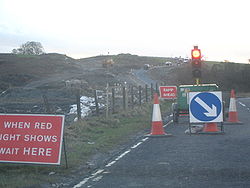Portable Traffic Signals (PTS)
| Portable Traffic Signals | ||
 | ||
| PTS deployed on the A70 in 2007 | ||
| Pictures related to Portable Traffic Signals (PTS) No pictures uploaded (Upload?) | ||
| Quick Links | ||
| Traffic Signals | ||
Portable Traffic Signals (PTS) are one of the more commonly encountered forms of temporary traffic management on single carriageways. They're colloquially known as Temporary Traffic Lights (TTLs), and may be referred to as such on a council's public list of roadworks.
General
Cost to hire a basic two head set, including a full set of temporary traffic signs, is in the region of £130-£150 per week, (2010 price). PTS can operate in either 2 phase (shuttle working), or 3 or 4 phases at junctions. PTS are not permitted to be used on motorways.
Operation
3 modes, vehicle actuated (VA), fixed time (FT) or manual (MAN). Unless otherwise permitted by the highway authority, portable signals should operate in VA mode at all times, as this is the most efficient, theoretically causing least delay. MAN mode must be used if a 10mph convoying system is in place. Faulty PTS, or PTS running in FT mode cause unnecessary delays.
Portable signal heads are fitted with microwave detectors, small radar boxes mounted either above or below the head. Vehicles approaching at speeds lower than 10mph between 5 to 40m (5-44 yards) upstream from the detector will not be picked up, so it’s important for drivers NOT to approach PTS at a very low speed in the anticipation that the signals will change as they get to them. Having said that, the controller has a “nudge” circuit fitted that inserts a demand into the system approximately every 2.5 minutes, forcing the signals to run through a complete cycle. The detectors do not react to departing vehicles.
Upon detecting an approaching vehicle, the detector sends a demand to the controller and in the absence of demands from other approaches, the signal will turn to green for the approaching vehicle. Note that correctly functioning PTS, running in VA mode, display a red light on ALL approaches, only changing to green if an approaching vehicle is detected. The controller will permit a green, (for a minimum of 7 seconds), to be displayed on any one approach until either no more vehicles are detected on that approach, or until the maximum green time has been reached, or a demand is registered on another approach. In the absence of any further demands the controller then changes back to “All-red” on all approaches.
Communication between heads and the controller is either by cable laid on the surface, (easily damaged on a construction site), or more commonly, wireless. It is common for the controller to be installed in one of the signal heads of a battery operated, wireless controlled set of signals, reducing the amount of separate pieces of equipment to be accommodated on site.
The maximum distance between signal heads should not exceed 300m (330 yards), as a lengthy “All-red” time between greens causes a significant reduction in traffic flow capacity through the works. It is possible to operate portable signals over a site length exceeding 300m (330 yards) but in this case MAN mode should used, with hand-held radio equipped operatives controlling discrete heads.
PTS in the vicinity of a level crossing should operate in MAN mode, it is extremely dangerous for traffic to be forced to stop on or move slowly over a level crossing. PTS must not be operated at or within 50m (55 yards) of a level crossing.
PTS are powered by either:
- Mains electricity, usually via a convenient street lighting supply and a transformer. Normally only used if the signals will be in place for more than a week or so.
- Generator, this form of power is both noisy and polluting, with the added problems of needing visits, (often out of hours), to ensure that the fuel tank doesn’t run dry and a regular maintenance regime for the engine.
- Rechargeable battery. Fully charged a set of batteries can be expected to last around 5 days. This type of equipment is the preferred option for short duration installations.
References and links
Department for Transport
- ARTSM Guidance on the use of Portable Traffic Signals, replaces DfT Pink Book
- Safety at street works and road works
- Traffic Signs Manual, Chapter 8, Parts 1 and 2, 2009
- TSRGD 2016
Highways Agency
- Highways Agency specification TR2501 Performance Specification for Traffic Signal Control Equipment for use at Haul Route Crossings
- Highways Agency specification TR2502 Specification for Portable Traffic Signal Control Equipment for use at Roadworks
- Highways Agency specification TR2503 Performance Specification for Pedestrian Facilities at Temporary Standalone Traffic Signals
- Highways Agency specification TR2504 Performance Specification for Vehicle Detection Equipment for Vehicle Actuated Portable Traffic Signals
(TR specifications available from http://www.tssplansregistry.org/homepage.asp )